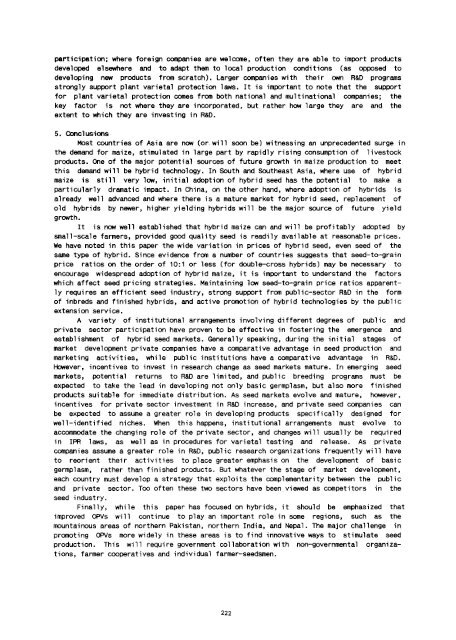Proceedings of the Fifth Asian Regional Maize Workshop - Search ...
Proceedings of the Fifth Asian Regional Maize Workshop - Search ...
Proceedings of the Fifth Asian Regional Maize Workshop - Search ...
You also want an ePaper? Increase the reach of your titles
YUMPU automatically turns print PDFs into web optimized ePapers that Google loves.
participation; where foreign companies are welcome, <strong>of</strong>ten <strong>the</strong>y are able to import products<br />
developed elsewhere and to adapt <strong>the</strong>m to local production conditions (as opposed to<br />
developing new products from scratch). Larger companies with <strong>the</strong>ir own R&D programs<br />
strongly support plant varietal protection laws. It is important to note that <strong>the</strong> support<br />
for plant varietal protection comes from both national and multinational companies; <strong>the</strong><br />
key factor is not where <strong>the</strong>y are incorporated, but ra<strong>the</strong>r how large <strong>the</strong>y are and <strong>the</strong><br />
extent to which <strong>the</strong>y are investing in R&D.<br />
5. Conclusions<br />
Most countries <strong>of</strong> Asia are now (or_will soon be) witnessing an unprecedented surge in<br />
<strong>the</strong> demand for maize, stimulated in large part by rapidly rising consumption <strong>of</strong> livestock<br />
products. One <strong>of</strong> <strong>the</strong> major potential sources <strong>of</strong> future growth in maize production to meet<br />
this demand will be hybrid technology. In South and SOU<strong>the</strong>ast Asia, where use <strong>of</strong> hybrid<br />
maize is still very low, initial adoption <strong>of</strong> hybrid seed has <strong>the</strong> potential to make a<br />
particularly dramatic impact. In China, on <strong>the</strong> o<strong>the</strong>r hand, where adoption <strong>of</strong> hybrids is<br />
already well advanced and where <strong>the</strong>re is a mature market for hybrid seed, replacement <strong>of</strong><br />
old hybrids by newer, higher yielding hybrids will be <strong>the</strong> major source <strong>of</strong> future yield<br />
growth.<br />
It is now well established that hybrid maize can and will be pr<strong>of</strong>itably adopted by<br />
small-scale farmers, provided good quality seed is readily available at reasonable prices.<br />
We have noted in this paper <strong>the</strong> wide variation in prices <strong>of</strong> hybrid seed, even seed <strong>of</strong> <strong>the</strong><br />
same type <strong>of</strong> hybrid. Since evidence from a number <strong>of</strong> countries suggests that seed-to-grain<br />
price ratios on <strong>the</strong> order <strong>of</strong> 10:1 or less (for double-cross hybrids) may be necessary to<br />
encourage widespread adoption <strong>of</strong> hybrid maize, it is important to understand <strong>the</strong> factors<br />
which affect seed pricing strategies. Maintaining low seed-to-grain price ratios apparently<br />
requires an efficient seed industry, strong support from public-sector R&D in <strong>the</strong> form<br />
<strong>of</strong> inbreds and finished hybrids, and active promotion <strong>of</strong> hybrid technologies by <strong>the</strong> public<br />
extension service.<br />
A variety <strong>of</strong> institutional arrangements involving different degrees <strong>of</strong> public and<br />
private sector participation have proven to be effective in fostering <strong>the</strong> emergence and<br />
establishment <strong>of</strong> hybrid seed markets. Generally speaking, during <strong>the</strong> initial stages <strong>of</strong><br />
market development private companies have a comparative advantage in seed production and<br />
marketing activities, while public institutions have a comparative advantage in R&D.<br />
However, incentives to invest in research change as seed markets mature. In emerging seed<br />
markets, potential returns to R&D are limited, and public breeding programs must be<br />
expected to take <strong>the</strong> lead in developing not only basic germp1asm, but also more finished<br />
products suitable for immediate distribution. As seed markets evolve and mature, however,<br />
incentives for private sector investment in R&D increase, and private seed companies can<br />
be expected to assume a greater role in developing products specifically designed for<br />
well-identified niches. When this happens, institutional arrangements must evolve to<br />
accommodate <strong>the</strong> changing role <strong>of</strong> <strong>the</strong> private sector, and changes will usually be required<br />
in IPR laws, as well as in procedures for varietal testing and release. As private<br />
companies assume a greater role in R&D, public research organizations frequently will have<br />
to reorient <strong>the</strong>ir activities to place greater emphasis on <strong>the</strong> development <strong>of</strong> basic<br />
germp1asm, ra<strong>the</strong>r than finished products. But Whatever <strong>the</strong> stage <strong>of</strong> market development,<br />
each country must develop a strategy that exploits <strong>the</strong> complementarity between <strong>the</strong> public<br />
and private sector. Too <strong>of</strong>ten <strong>the</strong>se two sectors have been viewed as competitors in <strong>the</strong><br />
seed industry.<br />
Finally, while this paper has focused on hybrids, it should be emphasized that<br />
improved OPVs will continue to play an important role in some regions, such as <strong>the</strong><br />
mountainous areas <strong>of</strong> nor<strong>the</strong>rn Pakistan, nor<strong>the</strong>rn India, and Nepal. The major challenge in<br />
promoting OPVs more widely in <strong>the</strong>se areas is to find innovative ways to stimulate seed<br />
production. This will require government collaboration with non-governmental organizations,<br />
farmer cooperatives and individual farmer-seedsmen.<br />
222

















